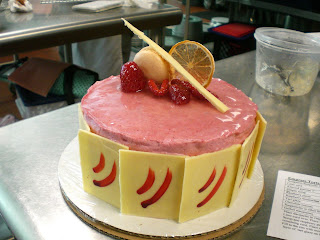Artisan Breads Week 8: Day 1
We suddenly got an order for 9 baguettes from the school restaurant. Each group made the full recipe of the French Bread, which makes about 4 loaves.

I've been practicing at home, so shaping these was easy. They turned out great, and the restaurant staff were happy :)
We made sweet breads today, which was a nice change from all the savory breads that we've been making: Cinnamon Raisin Swirl and Cranberry Walnut Braid. We also made a biga for Ciabatta and the rye starter for the Pumpernickel Bread for Day 2.

Cinnamon Raisin Swirl. After the bread is baked, the loaves are brushed with butter and dusted with cinnamon-sugar. The whole kitchen smelled like cinnamon-y goodness.

Cross-section of the Cinnamon-Raisin. Nice swirly action going on here.

Cranberry Walnut Braid. Nice, mahogany color! We substituted dried cherries instead of the cranberries. I decided I'm not a big fan of dried cherries... nevertheless, it still tasted great.
Artisan Breads Week 8: Day 2
We used the biga and the rye starter prepared on Day 1 to make Ciabatta and Pumpernickel Bread. I made the Pumpernickel while my other teammates made the Ciabatta and the Challah.
Unbeknownst to a lot of people, Pumpernickel Bread's dark color comes from cocoa powder--not a super dark rye flour. The dough was super soft, and was quite difficult to handle. When I loaded the loaf into the oven after proofing, it got bumped in the back; one end of the loaf got squished in and it came out smaller than it was supposed to :( It still tasted delicious! I used it to make a roast beef sandwich with home-grown (and organic!) tomatoes and cukes and Dijon-mayo (with a dollop of tonkatsu sauce). Mom, who's not too fond of dark breads, pronounced it divine :)

Ciabatta breads and Pumpernickel. My friend also had some trouble with the Ciabatta. The dough was so soft that it stuck to the flour-dusted cloth that she was proofing it on. The loaves tore a bit, and got deflated. I don't think I've ever heard anyone spew out 20 expletives in 30 seconds.

But, despite the mishaps, her Ciabatta still turned out very nicely. Tender and soft on the inside, crusty on the outside. I made another sandwich with this one, with ham, cheese, tomatoes and cukes.
Challah is a traditional Jewish bread, eaten on the Sabbath. Enriched with eggs and butter, it is quite delicious, like a milder version of brioche.

We shaped ours into a turban braid. I made French toast using this bread for breakfast.
So that's it for Week 8. I've been baking breads at home too, so I'll post them as soon as I have the time...



















